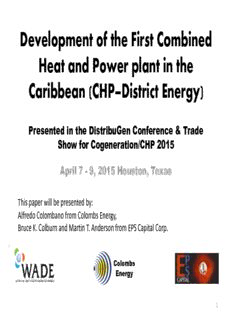
Alfredo Colombano PDF
Preview Alfredo Colombano
Development of the First Combined Heat and Power plant in the Caribbean (CHP–District Energy) Presented in the DistribuGen Conference & Trade Show for Cogeneration/CHP 2015 April 7 - 9, 2015 Houston, Texas This paper will be presented by: Alfredo Colombano from Colombs Energy, Bruce K. Colburn and Martin T. Anderson from EPS Capital Corp. Colombs Energy 1 CEPM’s Facts CEPM Overview CONSORCIO ENERGETICO PUNTA CANA MACAO (CEPM), • Is a privately owned utility company engaged in generating, transmitting, and distributing electricity through two isolated integrated power systems serving the fast growing tourism-based Punta Cana-Bávaro and Bayahibe regions in the Dominican Republic. • Serves 60 hotels with approximately 35,000 rooms in these tourist destinations as well as approximately 17,000 commercial and residential customers. • Company’s installed capacity is 90 MWe with Wartsila and Hyundai diesel engines operated using HFO. • CEPM also supplies thermal energies (5,000 TR chilled water, hot water and steam), with sales of: • 700 GWhe/year of electric energy, • 44 GWhcw/year of chilled water, • 22 GWhdhw/year of domestic hot water. 2 What is a District Energy ? District energy systems produce steam, hot water or chilled water at a central plant. The steam, hot water or chilled water is then piped underground to individual buildings for space heating, domestic hot water heating and air conditioning. As a result, individual buildings served by a district energy system don't need their own boilers or furnaces, chillers or air conditioners. The district energy system does that work for them, providing valuable benefits including: Improved energy efficiency Enhanced environmental protection Fuel flexibility Ease of operation and maintenance Reliability Comfort and convenience for customers Decreased life-cycle costs Decreased building capital costs Improved architectural design flexibility 3 Energy - Efficiency Comparisons From: International District Energy Association (IDEA) From: International District Energy Association (IDEA) 4 Chilled Water production with Electric Chiller (Without Cogeneration) 10 MWe (40%) 8 MWe Fuel Oil Energy HFO 25 MW (100%) 2 MWe 5 MWcw (1,421 RT) Chiller with electric compressor COP 2.5 5 Chilled Water Production with Absorption Chiller (With Cogeneration) 8 MWe (40%) Fuel Oil Energy HFO 20 MW (100%) 20% of reduction 7 MWth (35%) 5 MWcw 1,421 RT) Absorption Chiiler COP 0.71 6 CEPM’s CHP-District Energy Project Overview • As part of the expansion of CEPM’s services to an Energy Services Company (ESCO), our team developed the First CHP-District Energy system in the Caribbean. • This system provides 5,000 TR of chilled water (using Absorption Chillers) and Domestic Hot Water (DHW) to Hotels located near to CEPM’s power plant. • Waste heat comes from the exhaust gases and cooling water (Jacket water, Oil Cooler, Intercooler) of Wartsila Diesel Engines 18V32 Vasa (6 MWe each) that consume Heavy Fuel Oil (HFO). • The distance from the power plant and the different Hotels is about 2.5 miles (4 kilometers), making the new hot water loop a viable installation process. 7 CEPM’s CHP-District Energy Project Overview (cont.) • Cooling is provided by locally based absorption chillers and the heat exchanger used to produce DHW (Domestic Hot Water) for both cooling and domestic hot water were installed inside the hotels. • The HTHW (High Temperature Hot Water) is produced in the power plant with a temperature of roughly 248ºF (120ºC). • At the hotel this HTHW supplies the thermal energy to drive single stage absorption chiller units. • The HTHW output after being used to provide chilled water via the absorption chillers is then connected to an additional set of heat exchangers to produce DHW, and the “spent” HTHW loop temp water is then sent back to the power plant with a temperature of +/- 158ºF (70ºC). 8 CEPM’s CHP-District Energy Project Overview (cont.) • In this way a large delta T 90ºF (50ºC) can be effected by using the single loop to serve two purposes, first high quality heat to run the absorbers, and second the lower temperature resulting water out of the chillers used for all or part of domestic hot water generation. • The key goal and advantage of this project is to recover waste heat from the operation of the existing diesel engines with an electric efficiency of 39.5%, and produce thermal energy which used to be wasted away and instead reuse part of it from the exhaust gases to create new economic value. • Only about 16% of the heat is recoverable due to limitations imposed by the dew point of the exhaust gases when HFO with 2.5 % Sulfur is used, about 25.2 % on the cooling water which is only recoverable to the level of about 9.1% , and the remainder is low temperature water used via cooling water to dump heat, with roughly an additional 3% by radiation to the surrounding area. 9 CEPM’s CHP-District Energy Project Overview (cont.) • The sole reason the power company would consider this type of additional new investment is that their system MWe load has been growing about 5% per year, so redeploying some electrical load into thermal does not really hurt their business economically, and the lower resulting lower utility costs to the resort hotels provides an economic incentive to those resorts to continue dealing with the utility, which otherwise the resorts would not have to. • All is economically done that benefits both the utility and the large resorts, to say nothing of helping control costs to the other local customers (more and more local businesses and homes are connecting to this grid, some having had their own small generator systems, or connected to an adjacent power source). 10
Description: